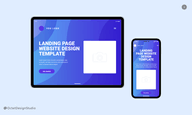A Beginner’s Guide to Wireframing in UX Design
Oct 14, 2021 • Reading Time 15 Mins • Tutorials• By Aakash Jethwani
Reading Time: 10 minutesIf you’re new to the concept of wireframing in UX design, then you’ve come to the right place.
When you’re starting out as a UX designer, you must be baffled with questions such as:
- How would you decide the elements of a web page for a new product?
- How many columns can be perfectly placed in your web and mobile applications?
- Where do you place the images, what size will fit the best, and how will links appear on your web page?
The answer to all the above questions is a wireframe. They are a crucial part of the product design process.
But, what are wireframes, why are they important while building a product from scratch, and which tools can you use to build them?
In this article, you will learn everything about wireframes in UX design.
Let’s get started.
Wireframe Basics
Meaning of Wireframes

Closely resembling an architectural blueprint, a wireframe is a two-dimensional outline highlighting the structure of the web page, anticipated user flow and behaviour, the interface, and the functionality of the overall product.
Wireframing is a process generally used by UX designers.
It helps everyone on the product design building team including the stakeholders to agree on where the information will be placed before the developers code the interface of the product.
It’s a vital process because it helps the UX designers to focus on page layout and user interaction with the product without worrying about the colours and typography.
If a user cannot understand the interface on a black and white wireframe, it doesn’t matter what colours and typography you choose to use.
Purpose of wireframing in UX design
There are mainly three purposes behind the process of wireframing. Let’s discuss each one of them.
1. Wireframes keep the product user-focused
Wireframes are best used as a communication medium, help extract genuine feedback from the users, spark thought-provoking communication with stakeholders, and generate unique ideas between the designers.
Conducting user research during the initial wireframing stage allows the designers to dive deep into the users’ minds and identify key pain points that help them build a product that feels user intuitive, is comfortable, and is easy to navigate.
2. Wireframes clearly and precisely define web and mobile application features
When presenting the initial idea to your clients, they may not possess any understanding of technical words used in UX design.
Wireframes help ease the process as it clearly displays and communicates all the features and their functioning visually.
With wireframes, you can easily explain to your stakeholders and clients the functionality of particular pages and the strategic placement of every component.
Lastly, wireframes simplify the entire interface of the product, offering designers an overview of the structure and find some unnecessary components to replace or remove.
3. Wireframes are fast and cheap to build
Wireframes are not much of a headache as they are easy to create and don’t affect the pockets deeply.
You can even start creating a wireframe for web and mobile applications with a pen and paper nearby.
Also, the free tools available will help you create sophisticated wireframes quickly with less effort.
Types of wireframes
There are three types when it comes to wireframing in UX design: low-fidelity, mid-fidelity, and high-fidelity wireframes.
The significant difference between each one of them is the level of detail they possess.
1. Low Fidelity Wireframes
Low fidelity wireframes are the simplest visual representation of the web and mobile application and act as the starting point of the design process.
They are mainly freehand without the use of scale, grid, and the weight of pixel.
Low fidelity wireframes eliminate any component that can act as a distraction during the initial design process. It only includes simple blocks.
Low fidelity wireframes are convenient as they can be made quickly with a pen and paper and offer the stakeholders a rough idea about the structure of the page.
2. Mid-fidelity wireframes
Mid-fidelity wireframes are the most commonly used by UX designers.
They are generally more advanced than low-fidelity wireframes but still lack components like colours and typography to avoid distractions.
They are best to make the clients understand the structure comprehensively without diving deep into each component’s complexity.
As opposed to low fidelity wireframes, mid-fidelity wireframes can only be created using digital tools and not with a pen and paper.
3. High fidelity wireframes
High-fidelity wireframes work on pixel-specific layouts, the most advanced of all.
While low fidelity wireframes may contain pseudo-Latin texts and grey boxes filled with X to depict the actual framework, high fidelity wireframes include real texts and sometimes, images too. This helps to better convey a realistic structure of the web and mobile applications.
High-fidelity wireframes are used to understand complex concepts such as hovering the mouse over the menu and interactive maps.
Four things to consider before making a wireframe
1. Device support
Finalizing the number of device support for your product is crucial before creating a wireframe.
Usually, the stakeholders will tell the supported devices for the product. These devices include:
- Desktop and mobile browsers
- Native mobile app platforms such as Android, Windows, and IOS
- Tablets
- Smartwatches
- Smart TVs and many such devices
However, there are instances when you will find that mobile responsive wireframes are requested and best suited to observing the goal of the product.
Once you’re ahead in the wireframing process, making these changes will be a hectic and time-consuming task.
Make sure to receive written approval from your client regarding the device support before starting the wireframe.
Also, during the wireframing process, if you find a feature not aligning with any specific device, either make it more device-specific or completely remove it.
2. Default screen size to begin
To manage the resources, it’s better to choose a default screen resolution for your product before designing the wireframe.
This will also set a basic ground rule for the team members.
It’s a time-consuming activity if you realised that you’ve started with a wrong resolution and now you’ve to rearrange the components all over again.
A safe bet would be to start with a small resolution and proceed to a big one. For example, you can start with 1024×768 pixels for desktop and 320×480 pixels for mobile.
However, at the end of the day, it’s better to know your target audience and their usage environment, and based on robust data and facts choose your default screen resolution for the project.
3. Level of Fidelity
The level of fidelity sets the tone for creating a wireframe.
It’s best to clear out the confusion regarding the definition of fidelity as it sometimes means different things to different people.
There are 3 types of fidelity – low, mid, and high as we’ve discussed above.
Whichever fidelity you choose to create wireframes, make sure that your team members and your stakeholders are on the same side.
Show them a few examples to make the concept crystal clear.
Undoubtedly, medium-fidelity wireframes are the best suited for designers and the team. Talk to your clients, if they want something comprehensive and flashy, go for high fidelity wireframes.
4. Alignment and Grid Systems
Lastly, to give a shiny and refined look to your wireframes, use a grid system to align the UI components. This will help you maintain consistency and discipline in your page layout.
Also, the grid systems will help your wireframes look professional and managed.
Best Wireframing Tools for UX designers
The best wireframe tools can help designers to create designs for a website or an app very easily from the beginning. Keeping the entire UI/UX design process in mind, many of such tools are designed.
Some tools are dedicated built for designing wireframes, while some offer added functionality of creating high fidelity prototypes and design systems as well.
The tool you choose depends on your need, whether you want to create rough sketches quickly or want to create wireframes for complex user flows.
Here we cover the top tools that designers use for wireframing in UX design, which will help you decide which one to choose.
1. Balsamiq
Balsamiq has been the go-to tool for UX designers in the industry.
Having a clear, concise, and easy-to-navigate interface and functions, Balsamiq is a perfect tool for those who are looking beyond a simple paper wireframe but less than pixel-focused wireframe.
What makes Balsamiq so lovable is its ability to create wireframes that depict sketches, making it obvious that the wireframe is a work in progress and not a finished product.
It also offers a huge library of reusable components which you can easily drag and drop to create multiple wireframes.
The accessibility of Balsamiq is a cherry on the cake. With the software available for Mac, Windows, and Linux, you can also use the cloud version saving yourself from all the hassle of installing the software on your system.
Lastly, Balsamiq has an in-built UI component library helping designers test their wireframes or multiple screen sizes.
2. Invision Freehand
Invision freehand is the digital version of creating wireframes on a smooth whiteboard.
It’s one of the basic yet powerful tools available to create wireframes.
What’s interesting about this tool is its ability to create a wireframe using the cursor or add images and blocks to form a wireframe template. Isn’t it amazing?
It’s one of the best tools for group effort as it allows other designs to sign in and draw at the same time. It also provides real-time sync with two powerful software – sketch and photoshop.
We have discussed in depth about invision app’s top 10 features in our previous article.
3. Marvel
Marvel offers designers the great ability to add custom UI components into their wireframes, In addition, Marvel offers pre-built wireframe templates such as a header block that contains a background colour, multiple menus for easy navigation, a footer menu, placeholder texts, and blocks for featured images.
Just like Invision freehand, Marvel also offers the feature to add multiple designers, collaborate, and create a fascinating product design.
This will help you create creative and user-centric wireframes in a lot less time.
4. Photoshop
Photoshop is the spotlight of the design tool world and will always be.
The range of features it offers is exemplary, from photo editing, digital painting to of course wireframing in UX design.
Just like Marvel, it allows you to add multiple artboards that fit with the corresponding screen and also offers you to add your own UI components or an external kit.
At first glance, the features may overwhelm you, but as you spend more time and practice, your experience of creating wireframes will enhance.
5. Adobe XD
Adobe XD is a dedicated software built to create and prototype UI/UX designs collaboratively. You can design, prototype and share your designs from a single application.
The free version of the application has a few limitations:
- 1 active shared document
- 1 active shared link
- 2 co-editors
To access all features of Adobe XD, you need to have a creative cloud subscription which costs roughly $10.60 or ₹800.
The best part about XD is that as it is a part of Adobe Creative Suite, it can easily import native files from other Adobe programs such as Illustrator, Photoshop.
6. Sketch
Sketch is a powerful yet lightweight vector design tool for macOS users. It can be used for anything from wireframes to modern UI and icon vector design
Its interface is far simpler and more intuitive than vector design heavyweights Affinity Designer and Adobe Illustrator. Sketch can be used to create wireframes quickly with a combination of artboards and vector design shapes.
As Sketch is a desktop app, it makes collaboration a bit tricky, as there’s no way to allow multiple designers to work simultaneously within a design file.
However, you can sync your design to Sketch Cloud, which allows you to share a link to the most recent version of your design, collect comments and other feedback, without having to waste time with a lengthy export process.
7. Figma
Figma, just like XD and Sketch is an all-in-one design tool that offers the option of creating wireframes too.
It has both browser-based and desktop applications. It allows you to mirror and preview your designs on mobile devices in real-time.
The best part is, it is a free tool that UX designers can use to create wireframes and collaborate with other team members. The limit for the free plan is 3 projects and 2 editors.
The Professional plan starts at $12 per editor/month and allows you to create team libraries. To implement organization-level design systems and administer plugins, you will need the Organization plan, which starts at $45 per editor/month.
8. Just In Mind
Justinmind is yet another tool for creating wireframes professionally. The most unique part about this wireframing tool is that it allows you to create a wireframe that can be tested as a working prototype from the start.
In fact, the ease with which you can create and share realistic wireframes can save you hours or days of work on any given project.
This makes Justinmind a great tool for anyone who wants to get real, in-depth feedback on designs much earlier in the wireframing stage of UX design (with minimal effort).
Apart from the content of the elements themselves, the layout of Justinmind is very easy to figure out: all of your design elements are on the left-hand side; the organization elements (like folders, list of screens, etc.) are on the right. It all just feels very intuitive, which we love.
9. Mockplus
Mockplus is a rapid wireframing/prototyping tool for designers to create interactive wireframes for websites and mobile apps.
This UX wireframing tool enables you to share and test design ideas across PCs and mobile devices from an early stage in the design process.
Not only can you add notes and documentation to each element in your design, but your project area in Mockplus also has room for you to create and save documentation in a text editor, save your style guide (so everyone is on the same page), and even create and assign tasks to your team.
You can review the feedback process as the tasks are linked to a project and even dialled down to an individual design within the project.
Conclusion
Wireframes may seem like a basic idea, but we cannot afford to overlook their significance in building a successful product.
Wireframing in UX design allows you to collect users, stakeholders, and designers’ opinions on key aspects like layouts, typography, colours, user flow, and the interface of the product.
The approval from the initial stage will not only help you create a user-centric product but also reduces the chances of revamping a component from scratch, which will cost a business thousands of dollars.
What’s better than creating a product that users will love and also will save you a ton of money during the process.
Subscribe to
blogs
Related Blogs
Benefits of UI UX Design: How it Transforms User Experience
Reading Time: 9 minutes In the dynamic world of digital interactions, UI/UX design stands as the backbone of creating meaningful and seamless experiences for users. Whether you’re a seasoned designer or just stepping into the realm of UI/UX, understanding the advantages of UI/UX Design and benefits of user experience design can significantly impact your approach to crafting interfaces that […]
Dec 28, 2023 • Reading Time 13 Mins • By Aakash Jethwani

Essential UI UX Design Tips for Outstanding UX Experiences
Reading Time: 9 minutes In the rapidly changing digital landscape, UI/UX Design holds unparalleled importance. Its significance lies in crafting experiences that resonate with users, ensuring their satisfaction and loyalty. A meticulously designed UI/UX becomes a secret weapon in the competitive tech space, setting a product apart from the crowd. Beyond aesthetics, it plays a pivotal role in increasing […]
Dec 27, 2023 • Reading Time 13 Mins • By Aakash Jethwani


















